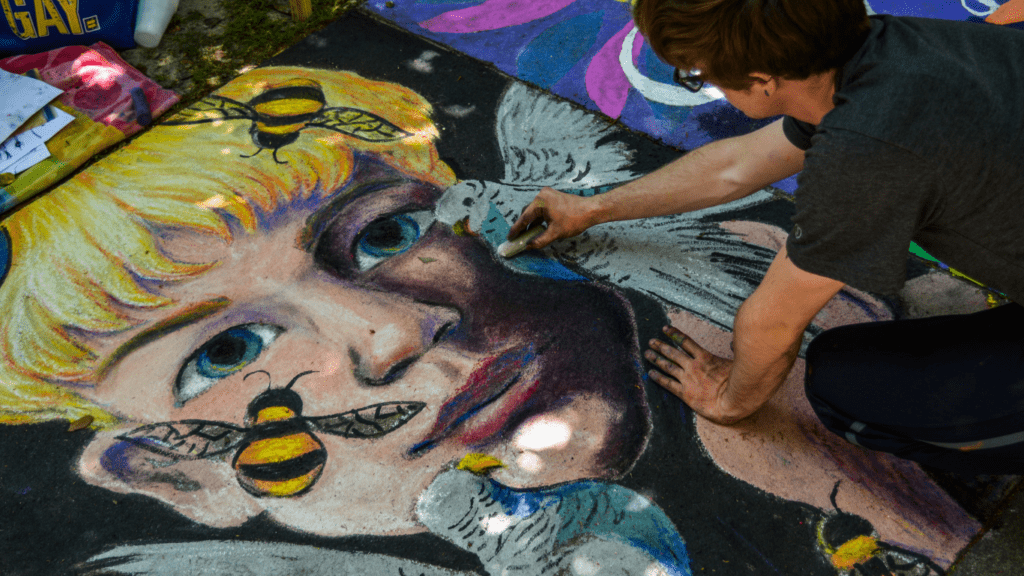Understanding the Importance of Building Your Art Brand
Building an art brand elevates your creations from hobby to business. A strong brand helps artists connect with their target audience, transforming their passion into a profitable venture.
Art branding isn’t just about having a pretty logo; it’s the complete experience surrounding your work.
Several benefits come with a well-established art brand. First, it enhances recognition. When people see your signature style or logo, they immediately associate it with your work.
This recognition builds trust and loyalty among your audience, encouraging repeat customers and referrals.
Second, a compelling brand differentiates you from other artists. In a competitive market, standing out is crucial. Your unique brand story, visual style, and voice set you apart, making your work memorable and resonant with your audience.
Finally, effective branding drives higher value and pricing for your art. Collectors and buyers are willing to pay more for well-branded art, perceiving it as higher quality and more desirable.
Abaxially, a strong brand enhances your credibility and professionalism, attracting galleries, exhibitions, and media opportunities.
Investing time and effort in building your art brand yields substantial long-term benefits in recognition, differentiation, and value.
Defining Your Artistic Identity
Building an art brand begins with defining your artistic identity. Discovering your unique style and crafting your personal story are essential steps in this process.
Discovering Your Unique Style
Unique style sets you apart in a crowded market. To uncover your style, I recommend analyzing your favorite works and identifying common themes, techniques, or subjects.
Consistency in these elements forms a recognizable pattern. Additionally, experimenting with different media and approaches helps refine your voice.
For example, blending abstract concepts with realism or focusing on a specific color palette can create a distinct look. By tracking these patterns, you can gradually develop a style that is both unique and authentic.
Crafting Your Personal Story
Personal stories connect deeply with your audience. Sharing experiences, inspirations, and challenges gives your art a narrative context. Start by reflecting on pivotal moments in your life that have influenced your work. Document these in a cohesive story that aligns with your artistic vision.
For instance, if a significant travel experience shapes your creations, highlight it in your story. Your personal tale should resonate with viewers and evoke emotional responses. Integrate this narrative into your brand’s messaging across websites and social media platforms to forge stronger connections with your audience.
Developing a Visual Identity
Developing a visual identity is essential for building your art brand. It helps create a recognizable and unique presence in the market.
Designing a Memorable Logo
A memorable logo is crucial for your art brand. It acts as a visual representation of your creative identity and sets you apart. Focus on simplicity and relevance.
A clean, uncomplicated design ensures easy recognition. Use elements that reflect your art style. For instance, if your art features bold colors and abstract shapes, incorporate similar motifs into your logo. Hire a professional designer if necessary to achieve high-quality results.
Selecting a Color Scheme
Choosing the right color scheme establishes consistency. It conveys your brand’s mood and personality. Use colors that complement your artwork.
For instance, if your art uses vibrant, warm tones, integrate similar hues into your color palette. Stick to a limited range of colors for coherence. Create a color guide to maintain harmony across all branding materials, from your website to social media profiles.
Building an Online Presence
Establishing an online presence is vital for any art brand’s success. It boosts visibility, engages your audience, and drives growth. Focus on strategic elements to maximize your brand’s reach online.
Creating a Professional Website
- A professional website serves as your digital gallery.
- Invest in a clean, user-friendly design to showcase your portfolio.
- Ensure seamless navigation to retain visitors and improve user experience.
- Include high-quality images of your artwork, and edit images to ensure they are polished and consistent.
- This content helps build a personal connection with your audience.
- Add contact information and social media links to facilitate engagement.
- Optimize your website for search engines (SEO) by using relevant keywords in titles, descriptions, and image alt texts.
Leveraging Social Media Effectively
Social media platforms amplify your reach to potential buyers and art enthusiasts. Choose platforms popular with your target audience, such as:
Consistent and engaging content is key. Post regularly, share behind-the-scenes looks, and use stories to engage followers. Incorporate hashtags relevant to your art style for broader visibility.
Interact with followers by responding to comments and messages. This practice builds a loyal community. Use analytics tools to track engagement and refine your strategy.
Networking and Collaboration
Networking and collaboration play crucial roles in building a successful art brand. Expanding connections and working with others open new opportunities for growth and exposure.
Connecting with Other Artists
Connecting with other artists builds a supportive community. Joining local art groups or online forums helps share experiences and advice.
Collaborative projects, such as joint exhibitions or group installations, increase visibility and introduce work to wider audiences. Engaging in social media platforms also fosters connections. Following other artists, commenting on their posts, and sharing content builds relationships and expands reach.
Participating in Art Exhibitions and Fairs
Participating in art exhibitions and fairs provides valuable exposure. These events attract potential buyers, curators, and gallery owners, increasing the chances of sales and partnerships.
Applying to local and national art fairs diversifies opportunities and boosts brand visibility. Exhibitions, whether solo or group, validate artistic work and attract media attention. Setting up a professional booth, displaying high-quality work, and engaging with visitors make a lasting impression.
Selling Your Art

Monetizing your art successfully requires a strategic approach. Optimize your sales by leveraging the right platforms and pricing your work correctly.
Choosing the Right Platforms
Understanding where to sell your art boosts visibility and sales. Use online platforms like Etsy, Saatchi Art, and Artfinder to reach global audiences.
These sites provide user-friendly interfaces and secure transactions, attracting art buyers actively seeking new pieces. Include social media marketplaces like Instagram and Facebook for direct interaction with potential customers.
Engage followers with behind-the-scenes content and live sales events. Utilize local galleries and art fairs if you want to expand your reach offline. These venues connect you with art enthusiasts and collectors, offering personal interaction that online platforms can’t replicate.
Pricing Your Work
Accurate pricing ensures fair compensation while attracting buyers. Base your prices on factors such as medium, size, materials, and time spent creating the piece.
Research similar artists in your niche to understand market standards. Use formulas like (Hourly Rate * Hours Spent) + Material Costs for consistent pricing. Avoid underpricing, as it might undervalue your work, but keep prices competitive within your market.
Periodically review and adjust pricing based on feedback and sales trends to ensure continued relevance and fairness.


